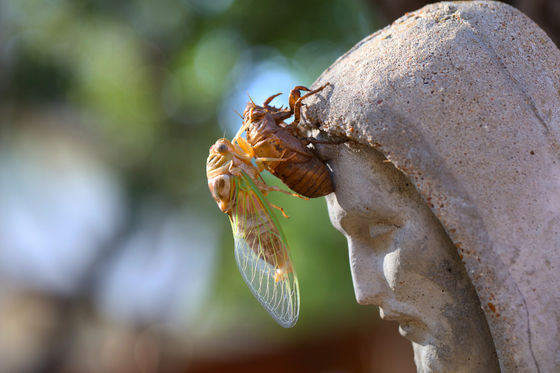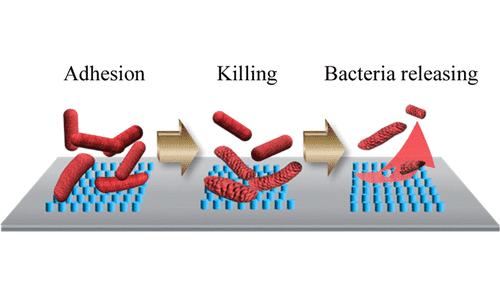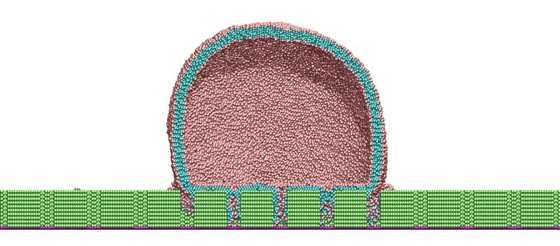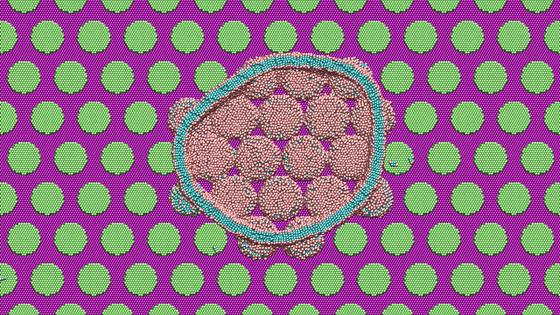The supercomputer revealed the secret of destroying bacteria that touched `` cicada wings '', demonstrating not only antibacterial action but also self-cleaning action

by
The cicada's wings, which can be said to be a summer tradition, have a strong antibacterial effect that kills the bacteria that come into contact with them. Researchers at Stony Brook University and Oak Ridge National Laboratory in the United States used supercomputers to clarify the workings of the fine structure of cicada wings, and discovered the mechanism that destroys bacteria and naturally self-cleansing. Reported.
Structure-Based Design of Dual Bactericidal and Bacteria-Releasing Nanosurfaces | ACS Applied Materials & Interfaces
https://pubs.acs.org/doi/10.1021/acsami.2c18121
Scientists use ORNL's Summit supercomputer to learn how cicada wings kill bacteria | ORNL
https://www.ornl.gov/news/scientists-use-ornls-summit-supercomputer-learn-how-cicada-wings-kill-bacteria
Cicada Wings Kill Superbugs on Contact, And We May Finally Know How : ScienceAlert
https://www.sciencealert.com/cicada-wings-kill-superbugs-on-contact-and-we-may-finally-know-how
Tadanori Koga and Maya Endo, polymer materials scientists at Stony Brook University, first became interested in cicada wings in a 2012 paper published in the scientific journal Small. Inspired by a report that the fine structure on the surface of a wing destroys bacteria by opening holes in them, Koga and his colleagues began research to reproduce the nano-sized columnar structures 'nanopillars' found in the wings of cicadas through a phenomenon called self-assembly. It has started.

Regarding the purpose of his research, Mr. Koga said, 'Cicada wings have a really beautiful pillar structure, so I wanted to optimize the structure while also using this. However, the mechanism was unknown, so we confirmed the most effective structure for killing bacteria by changing the size and height of the pillars and the spacing between the pillars. The whole picture of this project is to try.'
Mr. Daniel Surratt of Brookhaven National Laboratory, who was in charge of creating the nanosample, conducted an experiment to make nanopillars with polymers using polystyrene and acrylic resin widely used in packaging materials and attach bacteria. , it was found that not only the bacteria were killed, but also the destroyed cells were automatically removed.

Cicada wings have nanopillars with a height of 150 nanometers (nm) and the distance between the pillars. It has been shown to destroy and keep germs at bay for at least 36 hours.
Research has been conducted to kill bacteria using microstructures, but if the dead bacteria are left as they are, dust and other bacteria will adhere to them and the antibacterial effect will be lost. It is said that the removal of dead bacteria was a demon for material scientists.
Regarding the discovery of this groundbreaking effect, Surrat said, ``When a fungal cell dies, its debris sticks to the surface, providing a foothold for fellow fungi to stick to. has stumbled because we haven't found anything that does a good job of dealing with surface debris without using chemicals that can be more or less toxic to the surrounding environment.'
Experiments have confirmed that nanopillars kill bacteria, but the mystery remains as to why the destroyed bacteria are removed. Therefore, the research team next asked Jan-Michael Carrillo, who works at the Nanophase Materials Science Center at Oak Ridge National Laboratory, to investigate the specific mechanism by which the bacteria are destroyed. .
When Mr. Carrillo performed a molecular dynamics (MD) simulation using about one million particles, it was found that the lipid membrane had a strong interaction with the nanopillars when the bacteria came into contact with the surface of the nanopillars. got it. Specifically, the lipid membrane strongly adsorbed to the surface of the nanopillars, causing the membrane to stick to the surface and corners of the pillars and be pulled, eventually breaking and destroying the bacteria.

In addition, after the dead bacteria peel off from the nanopillars, fragments remain, but when exposed to water, they become fine particles called

Regarding the results of this research, Endo said, ``At first, we thought that the tall nanopillars pierced the bacterial membrane like needles, but whether the nanopillars are tall or short, the bacteria automatically What is more unexpected is that the debris did not adhere to the surface.Until now, we thought that the cicada's wing surface was clean because the cicada moved its wings to shake off debris. But our research proves that cicada wings are just self-cleaning.'
It is expected that this research, which uses familiar materials to physically destroy bacteria and keep the surface clean, will realize a coating that prevents the propagation of ``super bugs'' that are ineffective against drugs on the surface of medical devices.
Related Posts:







